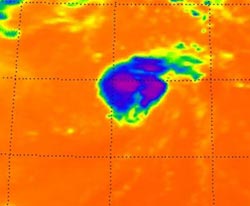NASA imagery reveals strength in Tropical Storm Michael's 'arm'

This is Tropical Storm Michael on Sept. 5 at 0611 UTC (2:11 a.m. EDT). Noticed the strongest thunderstorms and coldest cloud top temperatures (purple) around the center of circulation and in a band of thunderstorms to the northeast of the center.<br><br>Credit: NASA JPL, Ed Olsen<br>
The Atmospheric Infrared Sounder (AIRS) instrument that flies aboard NASA's Aqua satellite captured in infrared image of Tropical Storm Michael on Sept. 5 at 0611 UTC (2:11 a.m. EDT) and noticed the strongest thunderstorms and coldest cloud top temperatures around the center of circulation and in a band of thunderstorms to the northeast of Michael's center.
Those cloud top temperatures were as cold as -63 Fahrenheit (-52 Celsius) and indicated strong thunderstorms with heavy rainfall.
On Sept. 5 at 11 a.m. EDT, Michael had maximum sustained winds near 50 mph (85 kmh). The area of tropical storm force winds have expanded over the last two days and now extend outward up to 60 miles (95 km).
Michael's center was about 1155 miles (1,855 km) west-southwest of the Azores islands, near latitude 28.3 north and longitude 43.3 west. Michael is moving toward the northeast near 6 mph (9 kmh) and is expected to continue in that direction for the next couple of days.
The National Hurricane Center expects the wind shear that has been battering Michael over the last couple of days to relax, which may allow Michael to become a hurricane by Friday, Sept. 7.
Media Contact
More Information:
http://www.nasa.govAll latest news from the category: Earth Sciences
Earth Sciences (also referred to as Geosciences), which deals with basic issues surrounding our planet, plays a vital role in the area of energy and raw materials supply.
Earth Sciences comprises subjects such as geology, geography, geological informatics, paleontology, mineralogy, petrography, crystallography, geophysics, geodesy, glaciology, cartography, photogrammetry, meteorology and seismology, early-warning systems, earthquake research and polar research.
Newest articles

Trotting robots reveal emergence of animal gait transitions
A four-legged robot trained with machine learning by EPFL researchers has learned to avoid falls by spontaneously switching between walking, trotting, and pronking – a milestone for roboticists as well…

Innovation promises to prevent power pole-top fires
Engineers in Australia have found a new way to make power-pole insulators resistant to fire and electrical sparking, promising to prevent dangerous pole-top fires and reduce blackouts. Pole-top fires pose…

Possible alternative to antibiotics produced by bacteria
Antibacterial substance from staphylococci discovered with new mechanism of action against natural competitors. Many bacteria produce substances to gain an advantage over competitors in their highly competitive natural environment. Researchers…





















